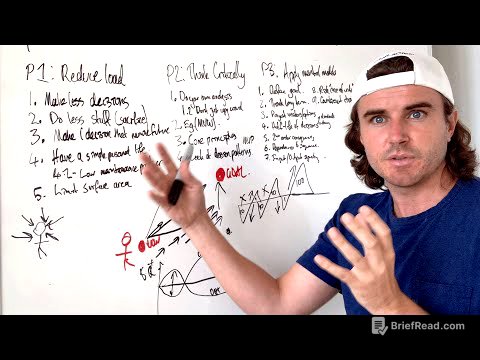TLDR;
This video explores the destructive nature of attachment, particularly towards women, and distinguishes it from genuine love. It argues that attachment leads to slavery, emptiness, and ruin, while love is freeing and fulfilling. The video uses historical examples and societal observations to illustrate how attachment has been a downfall for many, and it provides steps to recognize, witness, and transform attachment into love and compassion through awareness and meditation.
- Attachment is often mistaken for love but leads to slavery and emptiness.
- Societal conditioning and media reinforce the idea of incompleteness without a partner.
- Recognizing attachment, witnessing it, and transforming its energy are key steps to freedom.
- Meditation and awareness are essential tools for breaking free from the cycle of attachment.
The Trap of Attachment [0:00]
The speaker begins by describing how easily a person's emotional state can be controlled by external factors, such as a phone call or a smile from a woman, leading to a loss of self-esteem and inner peace. This dependence makes individuals slaves to their emotions, with their lives dictated by the actions and reactions of others. The speaker emphasizes that this isn't a new phenomenon, citing historical examples like the Mahabharata, where Draupadi's insult sparked a war, and the downfall of kings blinded by love, to illustrate the destructive power of attachment throughout history.
Attachment vs. Love [1:57]
The speaker distinguishes between love and attachment, stating that attachment is an addiction, similar to alcoholism or gambling, where the object of desire becomes indispensable. Attachment initially feels sweet but quickly turns into poison, causing pain and disruption in one's life, making it difficult to concentrate, pray, or even think of anything else. The speaker stresses that love sets you free and deepens you, while attachment makes you a slave and leaves you hollow. Attachment views the other person as an object to be possessed, driven by desire, hunger, and a thirst for power, rather than genuine affection.
Historical Downfalls [3:52]
The speaker uses the example of Ravana, a powerful and intelligent king, whose downfall was caused by his attachment to Sita, which overpowered his conscience and led to the destruction of his empire. Similarly, individuals today risk losing their careers and potential if they fall into the trap of attachment. Love, on the other hand, accepts the other person completely, without conditions, and gives freedom. Attachment creates bondage, turning the other person into property, leading to heartbreak and ruin when that "property" is lost.
The Nature of Love and Attachment [5:29]
Love is described as freedom and flight, remaining intact even if the other person leaves, as it doesn't depend on conditions. Attachment, however, is conditional, with happiness dependent on the presence of the other person, making it temporary and prone to breaking. The speaker points out that many people in relationships are unhappy because they are in attachment, constantly binding each other, which creates distance and drives love away. In love, the other person is seen as a flower, beautiful in all stages, while in attachment, they are seen as property, valued only when possessed.
The Roots of Attachment [7:44]
Attachment is not sudden but a seed sown since childhood through societal conditioning, family, religion, stories, films, and songs that promote the idea of incompleteness without a partner. This lie becomes deeply ingrained, making attachment a religion, where the eyes search for the object of desire upon waking, and life feels incomplete without them. The speaker references Duryodhana's grudge against Draupadi, which led to a devastating war, and modern examples of people dropping out of college or committing suicide due to attachment, highlighting the blindness it causes.
Attachment as Slavery [10:14]
The speaker describes how attachment traps individuals, causing them to lose sleep, scatter their attention, and waste energy that could be used for work, meditation, and creativity. This condition affects everyone, from kings to poets, leading to the loss of empires, spiritual practices, and souls. Attachment slowly makes one a prisoner, offering sweetness initially but gradually becoming a rope that binds and leads to a loss of sanity. The media deepens this fascination by using feminine charm to sell products, exploiting man's slavery to attachment.
Breaking Free from Attachment [12:24]
The first step to letting go of attachment is recognizing it as such, distinguishing it from love and understanding it as a game of the body and mind. The second step is to be a witness, observing the restlessness and imaginations that arise without suppressing them, allowing the blindness to calm down. The third step is energy conversion, transforming the power of attachment and lust into love and compassion by watching the energy rise within and allowing it to reach the heart or the third eye, transforming it into love or meditation.
Steps to Overcome Attachment [14:42]
The fourth step involves recognizing the temporary nature of the body and beauty, understanding that attachment is only a few years old and that all this is fleeting. The fifth step is meditation, sitting with eyes closed and observing where the mind wanders, allowing it to calm down and realizing that attachment is a habit, not a nature. The speaker emphasizes that losing attachment to a woman does not mean hating her but understanding one's own hunger reflected in her.
The Path to Freedom [15:56]
The speaker concludes by stating that only those who recognized attachment became free, citing examples like Buddha, Mahavir, and Kabir. He urges viewers not to close their eyes and mistake attachment for love, or they will face the same brokenness, emptiness, and ruin as countless others. The key is to identify the root of attachment and observe it with a witness attitude, allowing it to dry up. Giving up attachment to women means breaking the slave within, leading to real freedom, where love and compassion survive, but slavery does not.
Conclusion: Awareness and Transformation [18:46]
The speaker reiterates that giving up attachment to a woman does not mean giving up the woman herself, but rather breaking the attachment so that she becomes a friend, companion, and mirror, not a prison. By waking up and transforming the energy of attachment into light through awareness, one can avoid the cycle of greed, attachment, breakdown, and destruction. The speaker encourages viewers to recognize attachment as distinct from love, opening the door to a life of freedom and dance.









